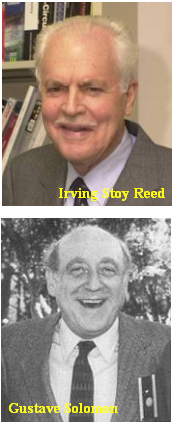Difference between revisions of "Aufgaben:Exercise 2.10Z: Code Rate and Minimum Distance"
From LNTwww
| Line 1: | Line 1: | ||
{{quiz-Header|Buchseite=Channel_Coding/Definition_and_Properties_of_Reed-Solomon_Codes}} | {{quiz-Header|Buchseite=Channel_Coding/Definition_and_Properties_of_Reed-Solomon_Codes}} | ||
| − | [[File:P_ID2526__KC_Z_2_10.png|right|frame|The | + | [[File:P_ID2526__KC_Z_2_10.png|right|frame|The inventors of the Reed-Solomon codes]] |
The codes developed by [https://en.wikipedia.org/wiki/Irving_S._Reed "Irving Stoy Reed"] and [https://en.wikipedia.org/wiki/Gustave_Solomon "Gustave Solomon"] in the early 1960s are referred to in this tutorial as follows: | The codes developed by [https://en.wikipedia.org/wiki/Irving_S._Reed "Irving Stoy Reed"] and [https://en.wikipedia.org/wiki/Gustave_Solomon "Gustave Solomon"] in the early 1960s are referred to in this tutorial as follows: | ||
:$${\rm RSC} \, (n, \, k, \, d_{\rm min}) _q.$$ | :$${\rm RSC} \, (n, \, k, \, d_{\rm min}) _q.$$ | ||
Revision as of 16:22, 4 September 2022
The codes developed by "Irving Stoy Reed" and "Gustave Solomon" in the early 1960s are referred to in this tutorial as follows:
- $${\rm RSC} \, (n, \, k, \, d_{\rm min}) _q.$$
The code parameters have the following meanings:
- $q = 2^m$ is an indication of the size of the Galois field ⇒ ${\rm GF}(q)$,
- $n = q - 1$ is the code length (symbol number of a code word),
- $k$ indicates the dimension (symbol number of an information block),
- $d_{\rm min}$ denotes the minimum distance between two codewords. For any Reed-Solomon code, $d_{\rm min} = n - k + 1$.
- No other code with the same $k$ and $n$ yields a larger value.
Hints:
- The exercise belongs to the chapter "Definition and properties of Reed–Solomon Codes".
- Information relevant to this exercise can be found on the "Code name and code rate" page.
Questions
Solution
(1) From the code length $n = 255$ follows $q \ \underline{= 256}$.
- The code rate is given by $R = {223}/{255} \hspace{0.15cm}\underline {=0.8745}\hspace{0.05cm}.$
- The minimum distance is $d_{\rm min} = n - k +1 = 255 - 223 +1 \hspace{0.15cm}\underline {=33}\hspace{0.05cm}.$
- This allows
- $e = d_{\rm min} - 1 \ \underline{= 32}$ symbol errors can be detected, and.
- $t = e/2$ (rounded down), so $\underline{t = 16}$ symbol errors can be corrected.
(2) The code $\rm RSC \, (2040, \, 1784, \, d_{\rm min})_2$ is the binary representation of the ${\rm RSC} discussed in (1) \, (255, \, 223, \, 33)_{256}$ with exactly the same code rate $R \ \underline{= 0.8745}$ and also the same minimum distance $d_{\rm min} \ \underline{= 33}$ as this one. Here $8$ bits (1 byte) are used per code symbol.
(3) From $d_{\rm min} = 33$ follows again $t = 16 \ \Rightarrow \ N_{3} \ \underline{= 16}$.
- If exactly one bit is corrupted in each code symbol, this also means 16 symbol errors.
- This is the maximum value that the Reed–Solomon decoder can still handle.
(4) The RS decoder can correct 16 corrupted code symbols,
- whereby it does not matter whether in a code symbol only one bit or all $m = 8$ bits have been corrupted.
- Therefore, with the most favorable error distribution, up to $N_4 = 8 \cdot 16 \ \underline{= 128}$ bits can be corrupted without the code word being incorrectly decoded.
